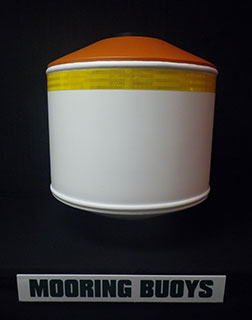PH: 1 (250) 652-4744
North Saanich, B.C.V8L 5X8
Mooring and Informational Buoys

Enviro Float offers a Transport Canada compliant, long lasting and durable and most reliable mooring buoy using the same technology as our Encapsulated Floatation.
These H.D.P.E. (high density Polyethylene plastic) Encapsulated solid foam core filled buoys are made to last. Now with the H.D.P.E. collar and 3” chain sleeve we have eliminated any chance of rust, corrosion or failure due to any metal components (galvanized or coated).
We at EFM also offer the chain (galvanized), swivel, shackles, rope, rings and a full range of mooring hardware.
For replacement of an existing or an entire new system we have the buoy to best suit your needs. Please call about our mooring set services that offer a concrete anchor, chain (galvanized) or rope and our Enviro Float Mooring Buoy with the installation.
Please note that the buoyancy ratings listed below indicate the maximum floatation the mooring buoy provides while Fully Submerged. Use 50% of this value as the weight that the mooring buoy can support.
As a generic rule you should select a mooring buoy offering slightly over twice the amount of floatation required for the weight of the anchor chain that you will be using. For example, 50 lbs. of anchor chain will require a little more than 100 lbs. of buoyancy.
Product Number MOORING BUOY SIZE SALT WATER BUOYANCY
EFM16 16” EFM Mooring Buoy 90 lbs.
EFM18 18” EFM Mooring Buoy 190 lbs.
EFM24 24” EFM Mooring Buoy 265 lbs.
EFM36 36” EFM Mooring Buoy 410 lbs.
- Highly visible 3M reflective tape comes standard with each EFM Mooring Buoy
- Please note that we can quote you on custom made signage for your EFM Mooring Buoy
- Installations are available. Please call for pricing.
More information:
Mooring Buoy FAQ (Frequently Asked Questions):
All docks and buoys are subject to the terms and conditions of the Navigable Waters Protection Act and the Private Buoy Regulations. However, there are provisions which exempt some docks and mooring buoys from requiring Approval from the Minister. The details of these exemptions can be found at:
Mooring buoys - http://www.tc.gc.ca/eng/marinesafety/tp-tp13585-mooringbuoys-3006.htm
Docks and Boathouses - http://www.gazette.gc.ca/rp-pr/p1/2014/2014-04-19/html/notice-avis-eng.php#trans2
Mooring buoys must be placed and marked in compliance with the Private Buoy Regulations. Full text at http://laws-lois.justice.gc.ca/eng/regulations/SOR-99-335/
The Private Buoy Regulations specify that buoys must also comply with the requirements set out in the Canadian Aids to Navigation (TP 968), which directs that a mooring buoy is coloured white and orange, with the orange colour covering the top one third of the buoy above the waterline. A mooring buoy must have a yellow light, if lighted. The light must conform to the standards and guidelines in the Canadian Aids to Navigation (TP 968). Retroreflective material, if used, must be yellow.
Full text at http://www.tc.gc.ca/publications/en/tp14799/pdf/hr/tp14799e.pdf
Any person or entity may seek to place a mooring buoy, provided the buoy meets the requirements of the Private Buoy Regulations, and the criteria within Transport Canada’s Marine Safety Management System (TP 13585) Tier II Procedure on Mooring Buoys have been followed.
Full text at http://www.tc.gc.ca/eng/marinesafety/tp-tp13585-mooringbuoys-3006.htmThe authority of the Navigable Waters Protection Act exists within the extent of the waterway below the High Water Mark (HWM). The Act does not speak to the placement of mooring buoys with respect to upland property rights.
Although the NWPA does not prohibit the placement of buoys in front of private property, there may be other local, regional, or Provincial regulations that do. It is always best to check with your local authorities before proceeding.
Some mooring buoys require Approval documents, and some do not. It depends on a few factors which are listed within Transport Canada’s Marine Safety Management System (TP 13585) Tier II Procedure on Mooring Buoys. Full text at http://www.tc.gc.ca/eng/marinesafety/tp-tp13585-mooringbuoys-3006.htm.
If a buoy meets all the criteria under Annex A of the mooring buoy policy document above, then no application is required and Transport Canada does not maintain a record of these. If a buoy falls under Annex B of the document, then the owner must apply for an Approval under the Navigable Waters Protection Act. The application process is free, and can be made electronically to NPPPAC-PPNPAC@tc.gc.ca.
No. The Navigable Waters Protection Act (NWPA) continues to apply to all bodies of water that are capable of being navigated by any type of floating vessel for transportation, recreation or commerce. The final authority to determine the navigability of a waterway rests with the Minister of Transport or his/her designated representative. The NWPA provides for the prohibition to build works in navigable waters, unless the work, its site and plans have been approved by the Minister of Transport on such terms and conditions as he/she deems fit. In addition, the Act provides for measures regarding removal of wreck or other obstacles to navigation and for the prohibition to throw or deposit any material in navigable waters.
For further guidance on the NWPA, visit http://www.tc.gc.ca/eng/programs-621.html
Under the Navigable Waters Protection Act, all unlawful works are subject to removal. However, due to resource limitations, actions carried out by the Department are prioritized according to their degree of obstruction to navigation and the potential hazard they present to public safety.
Transport Canada is actively involved in several multi-agency collaborative initiatives to develop long-term solutions to known areas of mooring buoy congestion and regulatory non-conformance. The Navigable Waters Protection Program (NWPP) will offer guidance and support to local community initiatives to alleviate problem areas, such as through providing input on developing public moorage facilities, or participating in the pre-development and consultative phases of community planning and by-law development.


